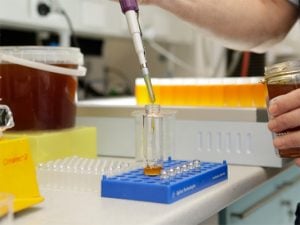
Laboratory testing of honey.
Source: http://www.chemcentre.wa.gov.au/Our-Services/Primary-Industry-chemistry/Honey-analysis
There have been a few media reports about honey adulteration in Australia in the past year. This has resulted in a 15-30% decrease in honey sales, translating to losses upward of $10 million. A recent AgriFutures Australia study reports that there are inherent problems with the methods used in these studies.
Honey is composed mostly of sugars, predominantly glucose and fructose with some sucrose. It also contains small amounts of a range of other substances including larger sugars, proteins, vitamins, amino acids and minerals. The levels of different sugars in honeys vary, mainly influenced by the floral source.
Various tests analyse different aspects of honey, including sugars, protein and electrical conductivity against a database of ‘typical’ honeys. One problem is that the databases used in these tests contain very few samples of Australian honeys. Australia has many unique plants, which may result in honey that does not conform to the ‘standard’’ honey produced elsewhere. For example:
- Red gum, leatherwood and Menzies banksia may have up to 10% sucrose as opposed to the accepted standard of less than 5%;
- Acacia pollen has low protein content; and
- The high dihydroxyacetone (DHA) and methylglyoxal (MGO) concentrations in Leptospermum honey (approximately 84 species in Australia, known for their high bioactivity) may cause them to fail adulteration tests.
Therefore, Australian honeys can be incorrectly determined to be adulterated using the methods in place for other regions of the world.
Video: Jamie Ayton from NSW Department of Primary Industries discusses the need for cheap, reliable tests to boost consumer confidence in honey
The report made a number of recommendations to increase consumer confidence in Australian honey:
Short term
- Develop a chemistry-based quality assurance program or code of practice, with associated logos
- A market surveillance program that tests domestic and imported products for compliance with regulations
- A Choice review to increase consumer awareness of the quality of Australian honey
- Use of quick, inexpensive screening methods such as near infrared, mid infrared or Raman spectroscopy
Medium to long term
- Development of validated and verified standardised methods to detect adulteration
- Laboratory proficiency programs to ensure results are reliable and repeatable
- A database of Australian honeys that reflects the true variability in the chemical composition and variability of Australian honeys
- Development of a Nuclear Magnetic Resonance database of Australian honeys. This is a powerful, quick and relatively simple test. However, the costs to set it up are substantial and there has been variability between laboratory results. There is some way to go toward improving this method
- Development of an Australian honey standard, reflecting the variation in Australian honeys
- Representation by competent Australian technical authorities at international standard meetings for the Australian industry to join discussions on international honey testing and educate the world on the unique properties of Australian honey and the need for adequate representation in databases used for honey testing
- Supplementary feeding guidelines: overfeeding bees and harvesting honey too early can result in honey appearing to be adulterated, adherence to feeding guidelines may reduce this risk
There are a number of articles online stating that you can test for honey adulteration at home via various methods. If this were the case, the world-wide honey industry would not be investing millions in research to develop an accurate test. None of these methods work.
Australian beekeepers are proud of the quality of their honey, as they should be. Australia has some of the best honey in the world. The unique flora of our country provides a vast array of honeys, some of which fail current testing methods due to their particular chemistry, rather than due to adulteration. Please continue to support the Australian beekeeping industry by buying 100% Australian honey.
Additional resources:
An ABC podcast on Australian honey testing featuring Peter McDonald (AHBIC), Mark Taylor (Macquarie University) and Jodi Goldworthy (Beechworth Honey).
Acknowledgements:
- Ayton, P. Prenzier, H. Raman, A. Warren-Smith, R. Meyer (2019) Review of chemistry associated with honey. AgriFutures Australia publication 19-031
- This article was reviewed by Steve Fuller and Diana Leemon
About the author Nadine Chapman

